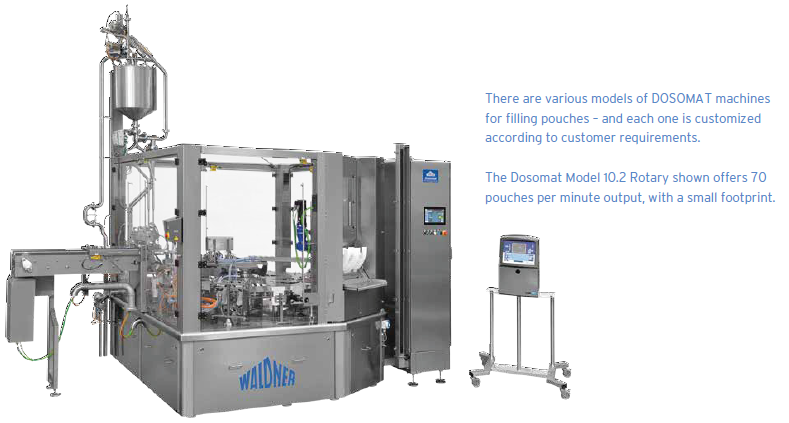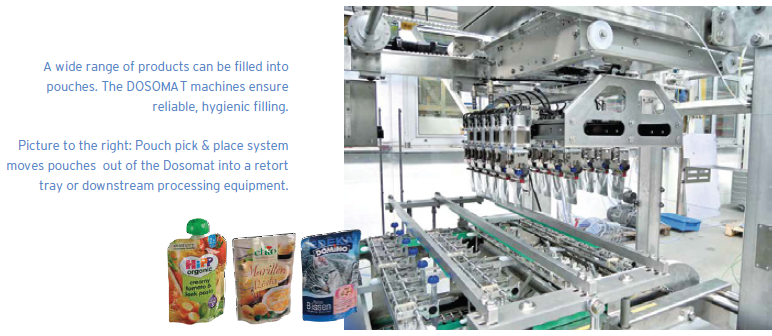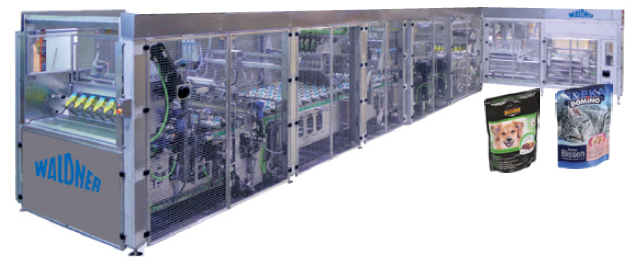In the Pouch – Filled to the Nearest Gram
When traveling or on-the-go, it is easy to carry food and snacks in a small bag. It’s convenient. And this is one reason why consumer pouch packaging is becoming ever more popular in the food industry and specifically the pet food segment. But how do you efficiently and effectively fill pouches on a commercial scale? Our editor, Anke Biester, pays a visit to the Waldner DOSOMAT assembly hall.

From cat food to rice or vegetables, instead of aluminum or glass containers, an increasing number of pouches can be seen on supermarket shelves. But why? And how does the food get inside? To answer this question, I arranged to meet with Robert Weber, design engineer for the DOSOMAT. Waldner offers robust pouch and spouted pouch machines in rotary design for small to medium capacity requirements, with a compact footprint. But today we’re standing in the enormous assembly hall of Waldner, in front of a 60’ long (18.29 mtrs.) packaging machine, which is currently running through its last test series before being delivered to the customer.
Space-saving and popular
Demand is on the rise. By way of explanation, Robert Weber pushes a small, colorfully printed pouch into my hand. It has a picture of a cute cat and some cat food on it. “It’s space-saving, light-weight and you can print over the entire surface,” says the engineer, summarizing the benefits of the pouch. Hundreds of pouches are already lying in the magazine – nicely packed flat – waiting for the machine. “And what if I want a different size?“ I ask, my gaze immediately falling on another magazine of different, much larger pouches. Robert Weber grins, “one magazine can handle different width pouches without any changeover, however if the height is different, the magazine can be easily changed. Let me demonstrate.” He clicks out the old magazine using two handles, and replaces it with the new one. “The rest of the process is fully automated,” he says.
Ink is used to indicate sterilization
His colleague, engineer Bernd Bodenmüller, starts up the machine. “Slowly, so we can see what’s happening.” He has everything under control on the HMI. The machine starts up. Suction cups are used to pick up the individual pouches and place them in two clips, holding the pouches standing upright. Held tight like this, in the next step, they are printed with a date code. This makes sense, because the pouches are currently still flat like a piece of paper. “Because the date code ink changes color after sterilization, it is a good indicator that this process has been completed,” explains Robert Weber.
Specially designed pouch carrier and Individually controlled servomotors
Once denested from the pouch magazine, via the vacuum suction cups, the pouches are transferred into the special pouch format carrier plates. Each plate has a holding system that firmly grips the pouches with eccentric clamps and has a dual rod system that allows for servo-controlled opening and closing of pouches as required on each station. The pouch carrier unit will open the pouches at the filling station or close them at the sealing station to preset parameters. The specially designed pouch carrier maintains registration, which is critical at each stage.
Overall equipment effectiveness is fur ther illustrated with the Dosomat discipline in design approach to the no pouch/no fill feature.

The filling process will continue in the rare event of a missed pouch or a pouch that f ails to open for filling. All other pouches in that row will fill without missing a beat. This means there is no downtime and minimal waste in this process.
All this is made po ssible by numerous servomotors that are capable of directing each and every pouch. “We measure and save all of the available parameters for each pouch in real time. This way we can quickly identify any potential faults during filling,” explains Bodenmüller. What a lot of programming! “Well, we’ve been working on this pouch f illing machine technology for 10 years, and we’re still finding little improvements.
Something like this isn’t created overnight,” replies the engineer, modestly, and he immediately discloses a new feature: “In the future it will be po ssible to use a mobile phone as a s ervice interface to request diagnostic and service data from the machine. A simple scan of the QR code on the control panel will be enough to request the data and have it sent in a convenient email, for example. Waldner Remote Diagnostics will be possible very soon.”
Clean filling with no strings attached!
Now the pouches are destined for the actual filling station. This is where a filling head is inserted into the pouch, filling it to the exact milligram with food from the storage container. But how will that work with cat food containing whole pieces? “it’s all about the timing,” grins Robert Weber. "We've found a smart solution, Waldner's Wisk-A™ nozzle provides dripless filling with an ULTRA precise cutting nozzle.
"Waldner’s proprietary filling technology enables the following benefits for the pet food market segment:
- Clean cut of the pet loaf: No strings attached!
- Accurate fill weights: no product giveaway, no waste
- Food retains texture & moisture, proven with over 100 varieties of pet food
Sealing with ultrasound
How do they come up with such ide as, I wonder? Meanwhile, the machine continues its demonstration with the sealing process. I discover that air is f irst pushed out of the pouch using s team, and may require the addition of CO2 or N2 to displace O2 from the pouch (according to customer request or requirement). The eccentric clamps move apart to flatten the top of the pouch, which also assists in air removal. Next, I hear a quiet, high-pitched sound as the vibrations and pressure of the ultrasonic sealing units hermetically seal the pouch. A fast and high-quality method that controls the sealing process through statistical measurements, ensuring the closure of the pouch. “The reliability of the seal is very important, and this is why we monitor it using a highly s ensitive distance measurement in the µm range.” This is followed by what is referred to as a cosmetic heat seal. A lightly ribbed closure provides the necessary grip for later being able to tear open the pouch, while als o giving it an attractive appearance.

Check weighing with Feedback
Each pouch is now placed on a set of scales and the weight is checked. If it does not meet the specifications, the pouch is no t only rejected, an automated message is sent to the filling station of precisely this pouch – and this then adjus ts the intake stroke for, in this case, the cat food. At this stage, specific pouches can be removed for sampling.
Direct Retort Tray Loading
A major benefit of the Waldner DOSOMAT pouch machine for retort applications is the direct placement of pouches into the retort trays. Normally, this is a manual operation requiring several operators. In this pouch machine, the number of lanes for the equipment match the number of pouches in one row of the retort tray. The pick and place unit moves the required number of pouch rows to fill the retort tray completely. The machine gently lays all of the pouches in an organized fashion into the retort trays, which are then stacked and sent for sterilization.
Data and more
And that’s it! “For every pouch, we automatically collect a data set of approx. 30-40 parameters,” says Bernd Bodenmüller, who programmed the machine. “It is a bit like an individual electronic calling card that is attached to each pouch. It is e asy to use for statistical analysis, and if there are any returns, it is easy for the manufacturer to work out where the problem occurred. It’s heading in the direction of Industry 4.0.” And what happens when something is wrong with the machine, with its myriad of individual parts? Bernd Bodenmüller taps on the panel and I see an exact representation of the machine.
WALDNER, located in scenic Wangen im Allgäu, Germany is a global market leader in the field of fully automatic filling and sealing machines for packaging a variety of consumer goods from food to beverage for over 100 + years. With over 1,300 employees and many more all over the world, Waldner’s expertise in rotary and inline filling and sealing machines is the reason Waldner is proud to be a global supplier to companies such as Kraft, Nestle, Unilever, General Mills, Mars, Master Foods, Ameriqual and Initiative Foods. Waldner separates itself from the rest by customizing their machines according to their customers’ needs. With the use of various sterilization methods and servo technology, Waldner guarantees that they not only produce a Grade A machine, but deliver a complete solution that will effectively do the job according to each client’s unique application requirement.
“Thanks to the detailed overview on the control panel, we are able to check everything down to individual format plates. We’re able to find a needle in a ha ystack, no problem. Another unique feature is that no t only can we then easily remove the individual format plates, we can continue with production without them, in other words, with a gap and the o ther form plates still in place. This means that the machine doe sn’t stand idle during maintenance.
I‘m impressed with everything the DOSOMAT team have developed with the design. As the Waldner slogan states, the team definitely strives to be “always one step ahead.” I would love to take another look at the control panel or simply keep watching the clips and servomotors doing their jobs, but the two engineers have to go. Their mobile phones have been ringing the whole time. Demand is simply t oo high.
- Machines operate at very high (95%) OEE Ultra-precise filling accuracy with almost zero product loss, minimizing "product give-away”
- State of the art drive systems, variety of dosing & closing systems
- Excellent sales, service & parts support
- More than 3,000 DOSOMATS delivered worldwide
Show moreShow Less
Show more...Show Less